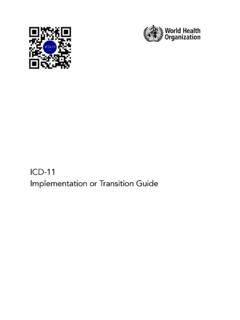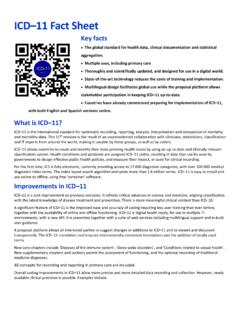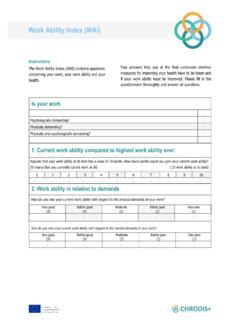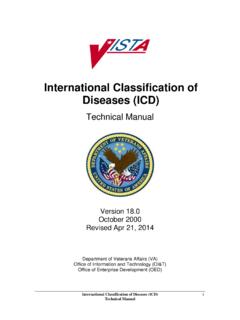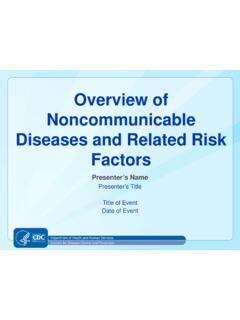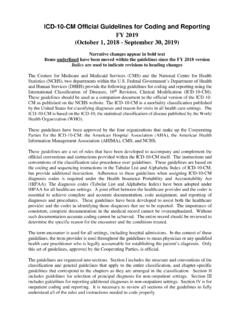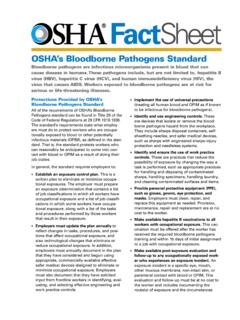Transcription of ICD-10 Volume 2 Instruction manual Fifth edition
1 ICD-10 International statistical classification of diseases and related health problems 10th revision Volume 2 Instruction manual Fifth edition2016 WHO Library Cataloguing-in-Publication DataInternational statistical classification of diseases and related health problems. - 10th revision, Fifth edition , : v. 1. Tabular list -- v. 2. Instruction manual -- v. 3. Alphabetical - classification. Health Organization. 978 92 4 154916 5 (NLM classification: WB 15) World Health Organization 2011. Reprinted in rights reserved.
2 Publications of the World Health Organization are available on the WHO website ( ) or can be purchased from WHO Press, World Health Organization, 20 Avenue Appia, 1211 Geneva 27, Switzerland (tel.: +41 22 791 3264; fax: +41 22 791 4857; e-mail: Requests for permission to reproduce or translate WHO publications whether for sale or for non-commercial distribution should be addressed to WHO Press through the WHO website ( ).The designations employed and the presentation of the material in this publication do not imply the expression of any opinion whatsoever on the part of the World Health Organization concerning the legal status of any country, territory, city or area or of its authorities, or concerning the delimitation of its frontiers or boundaries.)
3 Dotted and dashed lines on maps represent approximate border lines for which there may not yet be full agreement. The mention of specific companies or of certain manufacturers products does not imply that they are endorsed or recommended by the World Health Organization in preference to others of a similar nature that are not mentioned. Errors and omissions excepted, the names of proprietary products are distinguished by initial capital reasonable precautions have been taken by the World Health Organization to verify the information contained in this publication.
4 However, the published material is being distributed without warranty of any kind, either expressed or implied. The responsibility for the interpretation and use of the material lies with the reader. In no event shall the World Health Organization be liable for damages arising from its use. Printed in FranceContents1. Introduction 12. Description of the International statistical classification of diseases and related health problems Purpose and applicability The concept of a family of disease and health-related classifications Diagnosis-related classifications Non-diagnostic classifications Information support to primary health care International nomenclature of diseases The role of WHO General principles of disease classification The basic
5 Structure and principles of classification of the ICD Volumes Chapters Blocks of categories Three-character categories Four-character subcategories Supplementary subdivisions for use at the level of the Fifth or subsequent character Chapter XXII, U codes 183. How to use the ICD How to use Volume 1 Introduction Use of the Tabular list of inclusions and four-character subcategories Two codes for certain conditions Conventions used in the Tabular list Categories with common characteristics How to use Volume 3 Arrangement of the Alphabetical index Structure Code numbers Conventions Basic coding guidelines 28iii4.
6 Rules and guidelines for mortality and morbidity coding Coding instructions for mortality: underlying cause of death Aim of the instructions: international comparability The international death certificate Basic concepts Coding instructions for mortality: selecting the underlying cause of death Find the starting point (Steps SP1 to SP8) Check for modifications of the starting point (Steps M1 to M4) Special instructions on accepted and rejected sequences (Steps SP3 and SP4) Special instructions on obvious cause (Step SP6) Special instructions on linkages and other provisions (Step M1) Special instructions on main injury in deaths from external causes (Step M4) Special instructions on poisoning by drugs, medicaments and biological substances (Step M4)
7 Special instructions on maternal mortality (Step M4) Special instructions on surgery and other medical procedures (Step M4) Coding instructions for mortality: multiple causes Introduction Uncertain diagnosis Either .. or Effect of connecting terms Malignant neoplasms Sequelae Specific instructions on other ICD categories Consistency between sex of patient and diagnosis Perinatal mortality: guidelines for certification and rules for coding Certification of perinatal deaths Statement of causes of death Tabulation of perinatal mortality by cause Coding of causes of death Coding rules Morbidity Guidelines for recording diagnostic information for single-condition analysis of morbidity data Guidelines for coding main condition and other conditions Rules for reselection when the main condition is incorrectly recorded Chapter-specific notes 1625.
8 Statistical presentation Introduction Source of data Level of detail of cause in tabulations The recommended special tabulation lists for mortality The condensed lists The selected lists Use of prefixes to identify the mortality lists Locally designed lists The special tabulation list for morbidity Description Modification of the special tabulation list for morbidity according to national requirements Recommendations in relation to statistical tables for international comparison Statistical tables Tabulation of causes of death Standards and reporting requirements related to fetal, perinatal.
9 Neonatal and infant mortality Definitions Reporting criteria Statistics for international comparison Presentation of causes of perinatal mortality Standards and reporting requirements related to maternal mortality Definitions International reporting Published maternal mortality rates Denominators for maternal mortality Proportion of deaths classified to ill-defined causes Morbidity Precautions needed when tabulation lists include subtotals Problems of a small population Empty cells and cells with low frequencies Recommendations 1896.
10 History of the development of the ICD Early history Adoption of the International list of causes of death The Fifth Decennial Revision Conference Previous classifications of diseases for morbidity statistics United States Committee on Joint Causes of Death Sixth revision of the International lists of causes of death The seventh and eighth revisions The ninth revision Preparations for the 10th revision 2047. Annexes International form of medical certificate of cause of death International form of medical certificate of cause of death Cause of Death on the Death Certificate In line with ICD-10 Quick reference guide 205 Suggested additional detail of perinatal deaths (stillbirths and liveborn infants dying within 168 hours [1 week] from birth)
